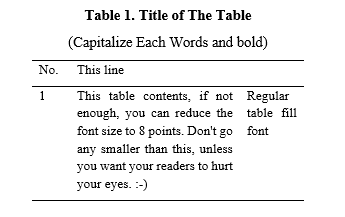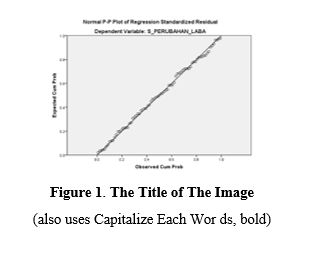Submissions
Author Guidelines
1. General Guidelines
All papers must be submitted online at :
https://jurnal.arkainstitute.co.id/index.php/histeria/user/register, where the author registers as a writer and/or is offered the position of online reviewer. If the author is having trouble submitting online, please contact the editor at infoarkainstitute@gmail.com. An original research piece that does not contain plagiarism or data falsification is the type of submission that can be approved for publication. Turnitin will be used to check each article for plagiarism, with a maximum restriction of 30%. Turnitin results greater than 30% will be returned to the author. During evaluation in the Histeria: Jurnal Ilmiah Sosial dan Humaniora journal the work has never been submitted to another publication and is not in the review process for publication elsewhere. Files for submission are in OpenOffice, Microsoft Word, RTF, or WordPerfect document file formats.
2. Manuscript Templates
The manuscript must be prepared according to the following author's guidelines in the article template (download the template here).
3. Manuscript Review
Reviewers evaluate each submitted manuscript in an independent capacity. In determining whether to publish, amend, or reject, their report or recommendation is considered. Should the manuscript be deemed unsuitable for publication in this journal by the reviewer, the author will receive a statement providing an explanation of the reasoning behind the decision.
4. Manuscript Revision
Manuscripts sent back to the author for revision must be returned to the editor without delay. Revised manuscripts can be sent to the editorial office via the Online Submission Interface (https://jurnal.arkainstitute.co.id/index.php/histeria/index). Revised manuscripts returned within two months will be considered new submissions.
5. Manuscript Format
The manuscript should be written in the most concise, consistent, and direct manner feasible. The number of pages consists of maximum 20 (twenty) pages (including figures and tables). Manuscripts are written on one side of A4 paper (210 x 297 mm) single-spaced. Normal margins, or top, bottom, right, and left margins of 2.54 cm, must be used for manuscripts. Times New Roman is the font used. The text is written in Indonesia or English. The manuscript is divided into several sections: Introduction (including study objectives and hypothesis development if available), study Methods, Results and Discussion, Conclusion, and References.
Title
The title should simply and clearly summarize the main idea, typed in sentence case and in the left margin (align left). The recommended title length is no more than 18 words with a font size of 14 pt.
Author
The journal operates a peer review process and uses blind review. To facilitate this process, the author's name (without academic title), institutional affiliation, and corresponding author's email address should appear on the cover sheet.
Author 1*, Author 2, Author 3, Author 4, Author 5
Name of University, Country
*Corresponding author. Email: author@author.com
ABSTRAK (11 pt, bold)
Presented in Indonesian. A well-prepared abstract allows readers to quickly and accurately identify the basic content of a document, determine its relevance to their interests, and thereby decide whether to read the document in its entirety. The abstract must be informative and clear enough, written clearly, and provide a clear statement of the problem, research objectives, research methods, findings, and conclusions. Abstracts should consist of 100 to 200 words. The abstract must be written in the past tense. Standard nomenclature should be used, and abbreviations should be avoided. No literature may be cited. Keyword lists provide the opportunity to add keywords used by indexing and abstracting services in addition to the keywords already present in the title. Wise use of keywords can increase the ease with which interested parties find our articles (9 pt).
ABSTRACT (11 pt, bold)
Presented in English. A well-prepared abstract allows readers to quickly and accurately identify the basic content of a document, determine its relevance to their interests, and thereby decide whether to read the document in its entirety. The abstract must be informative and clear enough, written clearly, and provide a clear statement of the problem, research objectives, research methods, findings, and conclusions. Abstracts should consist of 100 to 200 words. The abstract must be written in the past tense. Standard nomenclature should be used, and abbreviations should be avoided. No literature may be cited. Keyword lists provide the opportunity to add keywords used by indexing and abstracting services in addition to the keywords already present in the title. Wise use of keywords can increase the ease with which interested parties find our articles (9 pt).
INTRODUCTION / PENDAHULUAN (11 pt, bold)
It must state the background of the article. The background is a brief description of the urgency or importance of the topic and its discussion; preliminary data should be provided; and an explanation of the relationship between the phenomenon and existing theories must be presented. In this part, the gap analysis, the novelty of the research, and finally the research objectives must be stated. Gaps in this study must include previous research. It should not be an extensive review of the literature. The introduction can be divided into several sub-chapters (optional). Citations are written in bodynote format and are relevant to the bibliography (recommended using the Mendeley application or other reference management application programs such as EndNote, Reference Manager, or Zotero) (10pt, spacing 1.0, spacing after paragraph 6pt).
The manuscript should be written as concisely, consistently, and as directly as possible. The number of pages consists maximum 20 (twenty) pages (including figures and tables). Manuscripts are written single-spaced on one side of A4-sized paper (210 x 297 mm). Manuscripts must have normal margins, or top, bottom, right, and left margins, namely 2.54 cm. The font used is Times New Roman. 10pt. Manuscripts can be written in English or Indonesian.
RESEARCH METHODS / METODE PENELITIAN (11 pt, bold)
The Methods section must be short but must include sufficient technical information and contain the type of research, research population, research samples or subjects, and data analysis techniques. Only new methods have to be described in detail. Cite previously published procedures in References.
RESULTS AND DISCUSSION / HASIL DAN PEMBAHASAN (11 pt, bold)
Results should include the rationale or design of the experiment as well as the results of the experiment. Results can be presented in the form of images, tables, and text. Research findings must be supported by adequate data. This section must answer the research hypothesis.
The discussion should be an interpretation of the results, not a repetition of the results. This discussion includes at least: an explanation of the meaning of the findings and why the findings are important; Support the answer with the results. Explain how your results relate to expectations and the literature; state clearly why the results are acceptable and whether there is any agreement or conflict with previous research results; consider alternative explanations for the findings; consider research implications; study limitations; and provide suggestions for further research.
Avoid writing in the form of bullet numbering or item list style; it is best to write it in the form of a descriptive paragraph, even though it is a list item. If it contains tables and figures, the numbering is a continuation of the previous number. Each table and figure must be given a title.
Table
The table is in the middle. Use Times New Roman and font sizes 8 to 11. Horizontal lines in the middle of the table do not need to be displayed; only display the heading and the very end, and there should also be no vertical lines. Make sure you create the table correctly via the Insert Table menu. Tables should be referenced in the text by writing something like: '... (Tables are written with a capital 'T').
Try not to truncate the table on different pages unless the size exceeds one page. If you have to truncate, don't forget to rewrite the header row for each column, given the same table serial number, and replace the title with Continuation. The table title does not end with a period. Tables do not need to use vertical lines.
As with tables, make sure each figure has a sequence number and a title. Make the images you use to look like they're professionally made and don't need to be framed. It is better to use black-and-white images.
CONCLUSION / KESIMPULAN (11 pt, bold)
The conclusion must contain confirmation of the problems that have been analyzed in the results and discussion sections. Write a conclusion concisely and clearly. It is not recommended that the conclusion be written in several parts or points. The conclusion is intended to help readers understand why your research is important to them after they have finished reading the manuscript. A conclusion is not simply a summary of the main topics discussed or a restatement of your research problem, but rather a synthesis of the important points. It is important that the conclusion does not leave any questions unanswered.
REFERENCES / DAFTAR PUSTAKA (11 pt, bold)
Written using the style of the American Psychological Association 7th edition, 80% of references must be primary sources, and it is recommended to use the Mendeley application or other reference management application programs such as EndNote, Reference Manager, or Zotero. The bibliography does not need to be divided into sections. The minimum number of references in the bibliography is 15 references. The following is an example of bibliography writing:
Book :
Nealon, J. T., & Giroux, S. S. (2012). The theory toolbox: Critical concepts for the humanities, arts, and social sciences. Rowman & Littlefield Publishers.
Journal with DOI :
Stojanowski, C. M., & Duncan, W. N. (2015). Engaging bodies in the public imagination: Bioarchaeology as social science, science, and humanities. American Journal of Human Biology, 27(1), 51-60. https://doi.org/10.1002/ajhb.22522
Journal without DOI :
Kusmanto, H. (2014). Partisipasi masyarakat dalam demokasi politik. JPPUMA: Jurnal Ilmu Pemerintahan dan Sosial Politik UMA (Journal of Governance and Political Social UMA), 2(1), 78-90. https://ojs.uma.ac.id/index.php/jppuma/article/view/582
Dictionary/Encyclopedia – print :
VandenBos, G. R. (Ed.). (2017). APA dictionary of psychology. Washington, DC: American Psychological Association.
Dictionary/Encyclopedia – online :
Arcus, D. (2016). Attention deficit / hyperactivity disorder (ADHD). In B. Strickland (Ed.), The Gale encyclopedia of psychology. http://www.gale.cengage.com/
Conference/Seminar paper in published proceedings – print :
Edge, M. (2016). Lifetime prediction: Fact or fancy? In M. S. Koch, T. Padfield, J. S. Johnsen, & U. B. Kejser (Eds.), Proceedings of the Conference on Research Techniques in Photographic Conservation (pp. 97-100). Copenhagen, Denmark: Royal Danish Academy of Fine Arts.
Conference/Seminar paper in published proceedings – online :
Tester, J. W. (2018). The future of geothermal energy as a major global energy supplier. In H. Gurgenci & A. R. Budd (Eds.), Proceedings of the Sir Mark Oliphant International Frontiers of Science and Technology Australian Geothermal Energy Conference, Canberra, Australia: Geoscience Australia. http://www.ga.gov.au/image_cache/GA11825.pdf
Theses, or Dissertation:
Putra, W. I. (2017). Peran Lembaga Adat Paser dalam pelestarian nilai-nilai sosial budaya lokal di Kabupaten Paser Kalimantan timur (Theses). Universitas Negeri Makasar. http://eprints.unm.ac.id/4342/
Submission Preparation Checklist
All submissions must meet the following requirements.
- The submission has not been previously published, nor is it before another journal for consideration (or an explanation has been provided in Comments to the Editor).
- The submission file is in OpenOffice, Microsoft Word, or RTF document file format.
- Where available, URLs for the references have been provided.
- The text is single-spaced; uses a 12-point font; employs italics, rather than underlining (except with URL addresses); and all illustrations, figures, and tables are placed within the text at the appropriate points, rather than at the end.
- The text adheres to the stylistic and bibliographic requirements outlined in the Author Guidelines.
Privacy Statement
The names and email addresses entered in this journal site will be used exclusively for the stated purposes of this journal and will not be made available for any other purpose or to any other party.










.png?updatedAt=1704683575756)












